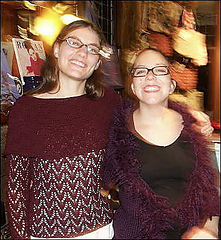patterns > Interweave Knits >  Interweave Knits, Fall 2004 and 1 more...
Interweave Knits, Fall 2004 and 1 more...
> Lace & Tuck Ensemble: Pullover






Lace & Tuck Ensemble: Pullover
Interweave SKU: EP0059
This ensemble consists of a sweater and matching capelet. Yardage given is for both pieces.
Lace & Tuck Ensemble: Capelet
Pattern description from Interweave Knits: “Shirley Paden never fails to combine stitch pattern and silhouette in pleasing harmony: this time in an elegant sweater-and-capelet duo. For the fitted, feminine under-sweater, she has used a delicate chevron lace pattern in a classic round yoke pullover. Tuck stitches add texture to the yoke and graceful, belled sleeves fall over the wrists. For added drama, Shirley gave the sweater a matching shoulder-hugging capelet, also worked in the round in a tuck-stitch pattern. In a light, alpaca yarn, the sweater and capelet are lofty and warm.”
Finished Size: 34 (37½, 41½, 45)“ (86.5 (95, 105.5, 114.5) cm) chest/bust circumference
Yarn: Indiecita Alpaca 3-Ply Sport (100% Peruvian alpaca; 185 yd [169 m]/50 g): #207 beige, 9 (10, 11, 12) balls (for both sweater and capelet). Yarn distributed by Plymouth Yarns.
Needles:
- Sweater body and sleeves - Sizes 9, 10, and 10½ (5.5, 6, and 6.5 mm): straight.
- Sweater yoke - Size 4 (3.5 mm): 40” (120-cm) circular (cir); size 7 (4.5 mm): 24” (60-cm) cir; and size 9 (5.5 mm): 32” (80-cm) cir.
- Adjust needle size if necessary to obtain the correct gauge.
Notions: Stitch holders; marker (m); size E/4 (3.5-mm) crochet hook; tapestry needle
Gauge: 30 sts and 49 rows = 7” (18 cm) in chevron lace patt from chart on size 9 (5.5-mm) needles
Originally Published: Interweave Knits, Fall 2004
Notes from Interweave Knits:
-
“The knitted cast-on method is used at the bottom of each piece to provide sufficient elasticity for the lace pattern. Be sure to place the newly cast-on stitches correctly onto the needle so they will not be worked as twisted stitches on the first row.”
-
“The back and front contain an exact number of rows, with o allowance for adjusting the length, so that the lace pattern for the body ends on a specific row. The sweater yoke and capelet contain an exact number of rows or rounds in order to accommodate the planned decrease for each neckline.”
-
“A garter-stitch selvedge (knit every row) is worked at each side; the selvedge stitches are not shown on chart.”
-
“Work increases and decreases for waist and sleeve shaping inside selvedge stitches.”
-
“Work single decreases as follows: (RS) K1 (selvedge st), ssk (see Glossary, page 129), work in patt to last 3 sts, k2tog, k1 (selvedge st); (WS) K1, p2tob, work in patt to last 2 sts, ssp, k1.”
-
“Work double decreases as follows: (RS) K1 (selvedge st); sssk (see Stitch Guide), work to last 4 sts, k3tog, k1 (selvedge st); (WS) K1, p3tog, work to last 4 sts, sssp (see Stitch Guide), k1”
-
“If there are not enough stitches as a result of shaping or sizing to work a yarnover or decrease with its companion decrease or yarnover, work the stitches in stockinette stitch (St st). For example, on the Arrowhead Lace chart, the sleeve for size 41/5” is a k2tog on Row 1, but this size does not have enough stitches to work the companion yarnover that appears 2 stitches to the right on Row 1. Instead, work the first stitch of Row 1 for this size as k1 to keep the stitch count consistent.”

585 projects
stashed
815 times
- First published: August 2004
- Page created: June 14, 2007
- Last updated: July 28, 2021 …
- visits in the last 24 hours
- visitors right now





